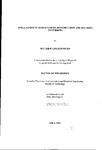APPLICATIONS OF ACOUSTO-OPTIC DEMODULATION AND DECODING TECHNIQUES
| dc.contributor.author | HICKS, MATTHEW GRAHAM | |
| dc.contributor.other | School of Engineering, Computing and Mathematics | en_US |
| dc.date.accessioned | 2013-11-04T12:52:45Z | |
| dc.date.available | 2013-11-04T12:52:45Z | |
| dc.date.issued | 1997 | |
| dc.identifier | NOT AVAILABLE | en_US |
| dc.identifier.uri | http://hdl.handle.net/10026.1/2563 | |
| dc.description.abstract |
This thesis describes the operation and performance of an acousto-optic demodulator system consisting of a laser source, an acousto-optic cell and a bi-cell detector. The bi-cell detector is made up of two photodiodes positioned side by side, separated by a small gap. Theory is developed to predict the following; the linear operating range for different gap sizes, absolute frequency sensitivity, system output in response to discrete phase changes, optimum gap size for phase demodulation, absolute descrete phase change sensitivity, the performance of the system in the presence of carrier noise and the effect of clipping the carrier signal on both frequency and phase modulated signals. A detailed model of the system has been written, using the software package Mathcad, which incorporates all the parameters that affect the performance of the physical system. The model has been used to study how the performance of the system changes as these parameters are varied. It is shown that the AO demodulator can be used in a number of ways; as a frequency demodulator, a phase demodulator and to demodulate digitally modulated signals, and that the optimum values of some parameters are different for each application. The model is also used to investigate the response of the system to a number of the most common forms of digital modulation. It is shown that it is possible, without any a priori knowledge of the signal, to identify each of these forms of modulation, and ultimately decode messages contained on the signals. The system can also be used to measure the frequency shift on pulse doppler radar. It is shown that the rms frequency error on a pulse using the AO demodulator is 150% better than that of existing systems. Experimental results are presented that are in good agreement with the results gained from both the theoretical and modelled analysis of the system. Finally suggestions are made for areas of further work on the signal processing of the output signals and possible uses of the demodulator in the future. | en_US |
| dc.description.sponsorship | DRA (Funtington) | en_US |
| dc.language.iso | en | en_US |
| dc.publisher | University of Plymouth | en_US |
| dc.title | APPLICATIONS OF ACOUSTO-OPTIC DEMODULATION AND DECODING TECHNIQUES | en_US |
| dc.type | Thesis | |
| plymouth.version | Full version: final and full version as approved by the examiners at the time of the award of your degree | en_US |
| dc.identifier.doi | http://dx.doi.org/10.24382/3342 | |
| dc.identifier.doi | http://dx.doi.org/10.24382/3342 |
Files in this item
This item appears in the following Collection(s)
-
01 Research Theses Main Collection
Research Theses Main


